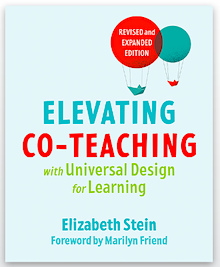3 Co-Teaching Traditions to Nurture & Celebrate
A MiddleWeb Blog
 Holiday traditions are all around us. We take time from our usual routines and begin to focus on our beliefs and customs that have always been a part of our lives. It’s time to give ourselves permission to take a breather. Whew!
Holiday traditions are all around us. We take time from our usual routines and begin to focus on our beliefs and customs that have always been a part of our lives. It’s time to give ourselves permission to take a breather. Whew!
We break from our routine teaching schedules and make time to connect with our families and friends, and if we’re lucky, we will take some time for ourselves. It’s a great opportunity to rejuvenate as we step off the teaching treadmill and shift our focus for awhile to other elements of our lives.
Over the next several weeks, it’s inevitable that we will reflect on how thankful, grateful, and appreciative we are for all of our blessings. We’ll have a chance to consider what’s going well—and what we would like to improve upon during the rest of the school year.
In the midst of our reflections, we get caught up in the joys of carrying on and sharing some holiday traditions. These traditions keep us connected to what has been important to us throughout the years. It is also a time to create new traditions and refine old ones in order to evolve with the times—and keep life interesting!
Three important co-teaching traditions
Which brings me to my focus for this week’s post—carrying on co-teaching traditions. I have identified a few co-teaching traditional beliefs that I think must be embraced in order to become a part of our co-teaching actions. These traditions are the center of all we do in the co-taught classroom.
If these three traditions are recognized, valued and practiced, all co-teaching roles and responsibilities will fall efficiently in place. These traditions must be present wherever co-teaching exists in order to create successful learning experiences for students and teachers.
1. Communicate: We know the power that communication holds. It can literally make or break relationships. Yet co-teachers have no time for broken relationships—the stakes are way too high. So, check in with your and your co-teacher’s beliefs about what positive communication looks like for the two of you.

For instance, keep a digital journal on a Google Doc and share with one another. Each co-teacher can check in on his or her own time to learn about the other’s perspective. If you are in need of solutions to your personal co-teaching situation, leave a comment below, and we will get in solution-seeking mode together!
2. Respect: Seize some moments of each day (or at least some each week) to notice one another’s talents and viewpoints. As we go about our daily routines, we’re always chasing the endpoints of our everlasting to-do lists. We have to make the time to appreciate what our co-teachers bring to our teaching world.

Just think how boring life would be if the two of you agreed on absolutely everything all the time. Relax into your reality and create a learning environment that includes the personalities and the talents of one another, and you’ll be amazed how the two of you can ramp up the learning for everyone in the classroom.
3. Persist: As you each set goals for yourselves and your students, share them with one another! Just think about what the power of two could do to make your set goals achievable. And when the path between your goals and achievement is not smooth—you must persist! Find another way—tweak your goals as necessary in order to keep your actions meaningful to what the students need. Identify the resources you need to support your actions as you strive to do your absolute best for students everyday—together!
Use this co-teaching tradition list to spark some co-teaching reality check discussions with your colleagues. What’s working so far this year? What can you do starting in January to fine tune your co-teaching practices?
I hope our readers enjoy memorable holiday traditions with their friends and families. I’m also looking forward to hearing about your reflections as you take some time to be mindful of your current co-teaching traditions. Allow yourself to extend your awareness into creating new, effective traditions that spark learning for all! All the best! Happy holidays!
So…what do you think? Are these co-teaching traditions a part of your experiences? What other traditions would you add to this list?

Elizabeth is also the author of Two Teachers in the Room: Strategies for Co-teaching Success (Routledge, 2017) and other articles and publications , including her long-running MiddleWeb column. You can follow Elizabeth on Twitter @ElizabethLStein and visit her website at https://www.steinelizabeth.com/.
































Love it! Wish I could join on the 23rd but will be with family. Thanks for sharing these co-teaching traditions. Can make or break a co-teaching team. Happy holidays to all!
Dr. Wendy Murawski, looking forward to future collaborations! Thanks for dropping by and adding your voice! Happy holidays!